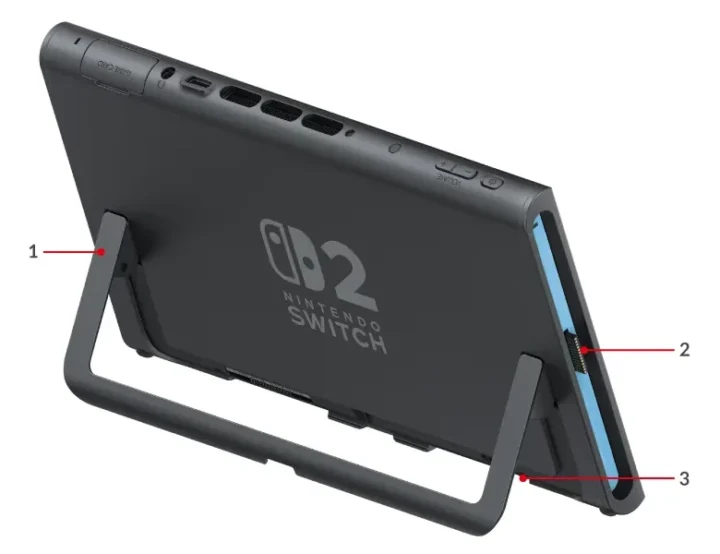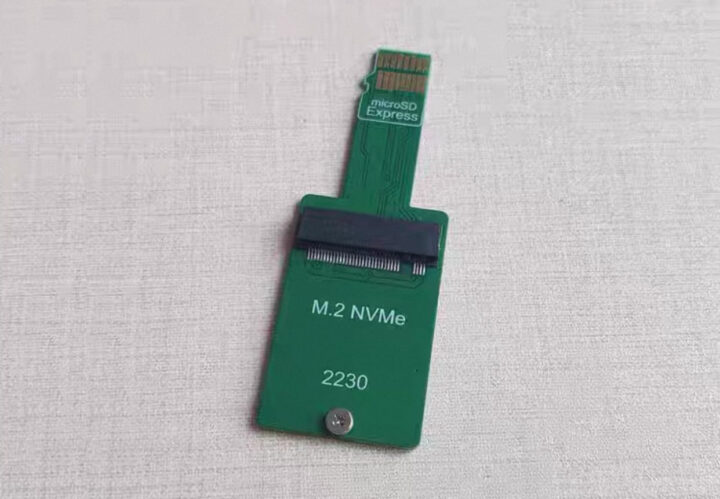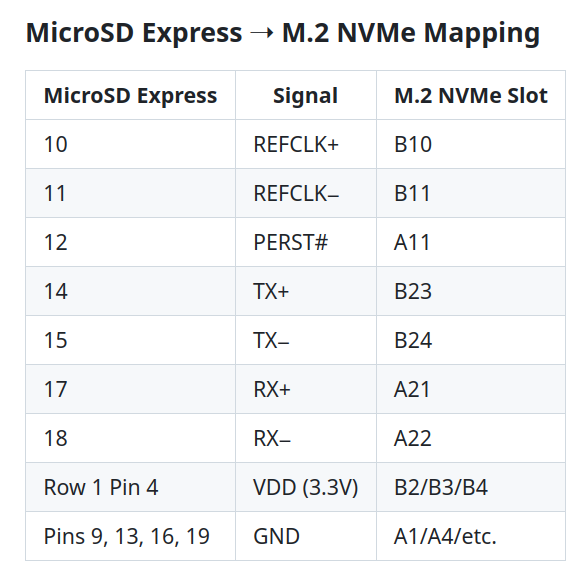The SD Association released the SD 7.1 standard with support for cards compliant with the microSD Express standard, enabling SSD-like performance on microSD cards by using a PCIe/NVMe interface, and more recent updates to the standard even enable speeds of up to 2GB/s.
Saying that adoption has been slow would be an understatement, but things have changed recently, thanks to the introduction of the Nintendo Switch 2 portable game console, the first mainstream device to support the new standard. NVNT has had fun with it by designing a microSD Express to M.2 NVMe adapter (SDEX2M2) for the Nintendo Switch 2 or other devices supporting the microSD Express standard.
The board design is pretty simple because it simply routes the PCIe signals from an M.2 NVMe 2230 SSD to the microSD Express connector. Three components can be found on the board: an M.2 2230 M-socket, a 220Ω ferrite bead, and an optional 10kΩ to 100kΩ pull-up resistor. The latter is used for the PERST# lane and may help with device state when idle, but more testing is needed to make sure it is required.
There are a few more details on the GitHub repository for the project. However, while KiCAD files for a microSD Express dummy card have been released, there aren’t any for the adapter itself, and the “Manufacturing Files” folder only includes the BoM, a signal mapping spreadsheet, PNG schematics, and a JSON file. Maybe it will be updated later, as the files were just released a few hours ago. [Update: It’s all nice, but this design won’t work in its current form, and an MCU is required. See comment below]
The project also comes with warnings, and users are told to only use low-voltage, low-power M.2 2230 NVMe drives, and not to try this with “standard” MicroSD slots because 1) it will not work, 2) it could potentially damage the host.

Inserting the M.2 NVMe SSD to microSD Express adapter to the Nintendo Switch 2 will be rather awkward as it will stick out of the device, but it’s nonetheless an interesting experiment.

Jean-Luc started CNX Software in 2010 as a part-time endeavor, before quitting his job as a software engineering manager, and starting to write daily news, and reviews full time later in 2011.
Support CNX Software! Donate via cryptocurrencies, become a Patron on Patreon, or purchase goods on Amazon or Aliexpress. We also use affiliate links in articles to earn commissions if you make a purchase after clicking on those links.






I would like to know it it works with any sdcard reader on computer or on raspberry’s sdcard reader.
You need an microSD Express card reader with PCIe signal, a regular microSD card slot or reader won’t work.
Could have been great to use with a RPI, but looks like it will not work, it need special support.
I can imagine a bios setting that locks microsd to software eject like Unix systems of bygone era locked floppies. Bypass would require “reset to factory” and or bios toggle
There is a eMMC adapter for MicroSD slot for the Raspberry Pi. It’s called RasPiKey.
It overreaches the Port, but at least you don’t have to worry much about durability of the SD Card this way.
Slow support is terrible as SD express is awesome for engineering convenience. Pop from phones into laptop boot from ventoy on microsd. No loss of speed nor reliability. No fiddling with adapters, loose screws, broken plastic, lost tools,, unhinged lcd madness. What more could an engineer want?
Gaming and a.i. beefy madness is what industry baby is after, milking that captive jail market. +1 for Nintendo switch 2
An engineer could ask for any support of software/driver using SD interface in such a way. Many many many embedded system processor does not support SD express.
It will not work without a proper SD handshake and CMD8 command response with PCIe flags as SD host controller needs to enable and reset PCIe side for this to work…
I was thinking this too, didn’t read the specs but no way there isn’t some kind of mode switching going on.
EDIT: Sure enough, someone brought it up https://github.com/NVNTLabs/switch2-SDEX2M2/issues/1
If this actually works, as others here have pointed out potential issues, it would be nice for a redesign with possibly using a ribbon cable for the connector. Or something else to give it flexibility and make it less protruding and rigid.
This could be made into a cheap microSD Express HAT+ for the Raspberry Pi 5. It would just be a simple PCB with PCIe signals routed to a microSD Express slot.
I’m not saying it would make sense for most cases, but we are talking about the Raspberry Pi ecosystem here, so I’m sure whoever makes one would be able to sell a few.
Here to provide small correction;
In both Switches, microSD (Express) slots are on the bottom (3), side port (2) is for controller.
Source: “NSwitch2 Important Information”, page 1 (https://www.nintendo.com/eu/media/downloads/support_1/nintendoswitch2/NSwitch2_ImportantInformation_UK.pdf)
Thanks. I got the image above from the “how to install the microSD Express into your Switch 2” page, and it was not super clear…
Thanks for featuring my project! I didn’t expect this to blow up so fast and wanted to make some clarifications!
Firstly, the pictured adapter is not my project but is instead a Chinese one that’s doesn’t work. I’m currently working on building a dummy card with breakout for prototyping, and then working on the final version wirh a flex connector. This will all of course need a mcu to handle translation, and I welcome all contributions on this open source project. Ive also reached out for some help too.